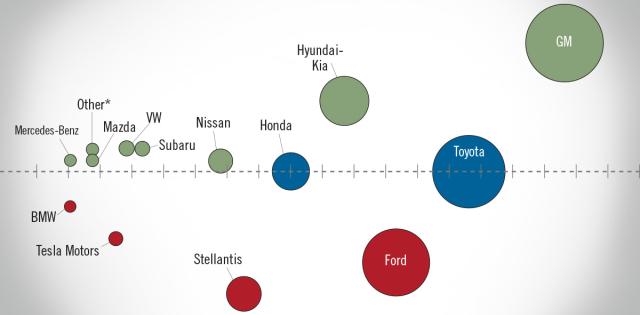The article below is sourced from Bloomberg Wire Service. The views and opinions expressed in this story are those of the Bloomberg Wire Service and do not necessarily reflect the official policy or position of NADA.
It’s been almost a year since the Volkswagen factory in Tennessee went fully electric. Last July, the 12-year-old plant, located between Couch’s Barbeque and Fat Boy’s Roadside Eats in Chattanooga, made 25 of Volkswagen’s ID.4 electric SUV, the first US production of the automaker’s first mass-market EV. By December, the factory was stamping out 100 ID.4s every day.
Electric vehicle production in North America is finally creeping up on EV demand, as industry incumbents like Volkswagen flex their manufacturing muscles. While newcomers such Lucid and Rivian are hustling to catch up to Tesla (and to their own targets), the old guard is quickly closing the production gap with the longtime EV frontrunner.
In December 2022, the latest month for which figures are available, fully electric vehicles accounted for 7% of North America car production, according to data compiled by Bloomberg Intelligence. That’s an increase from 4.7% in December 2021, and up from 4% for the first half of 2022. Tesla led the pack by stamping out 52,300 vehicles in December, followed by Ford with an estimated 9,300 electric cars, trucks and vans.
“We're selling every one we can,” Ford Chief Financial Officer John Lawler said on a conference call last month.
Indeed, while American EV demand remains hard to pin down, it is likely far higher than supply. Some 26% of US drivers say they intend to buy an electric vehicle, according to the American Automobile Association. And if other countries are any guide, that is the precise share of new car sales in the US that could be fully electric by the end of 2025 — that is, if there are enough EVs to purchase.
“What we’ve seen in the past year is a tremendous growth in what we call the mass market,” said Elizabeth Krear, vice president of the EV practice at JD Power. In October, for example, a JD Power survey found that more EV customers were considering a Chevy than a Tesla, Krear says. (Though Tesla regained its bragging rights after cutting prices in January.)
The year-end EV blitz suggests supply is gradually closing the gap with demand, and buying an electric car is likely to be less fraught for Americans in coming months. But US EV production is still very much in first gear. Ford plans to have its factories on pace to crank out 600,000 electric vehicles a year by the end of 2023; that would be a six-fold increase over its output in 2022. The automaker aims to push that pace to 2 million units by the end of 2026.
General Motors, meanwhile, hopes to pass Ford and become the runner-up to Tesla on EV manufacturing volume; the carmaker is spooling up production of its GMC Hummer, Cadillac Lyriq and Chevrolet Blazer, due out this summer. “We’re confident that GM will be the second largest seller of EVs in the US industry this quarter,” spokesman James Cain said in an email. “We’ll grow from there.”
The manufacturing rookies, meanwhile, are also promising progress, albeit more modest. Rivian told investors it will make 50,000 vehicles this year, though reportedly gave workers in the factory a slightly more bullish goal.
Lucid said it will make between 10,000 and 14,000 vehicles this year, though its plant in Arizona has the capacity to manufacture some 155,000 cars. “Production is no longer our bottleneck,” said Lucid spokesperson Nat Lingo; the greater challenge is building consumer awareness (hence, the company’s splashy commercial tied to Sunday’s Academy Awards broadcast).
Back at Volkswagen, there are plans to crank out another 200,000 EVs a year at a new plant in South Carolina that will open in 2026. In the meantime, the Chattanooga plant is only getting busier. Its goal is to manufacture 7,000 EVs a month — 233 squeaky-new ID.4s every day.
For more stories like this, bookmark www.NADAheadlines.org as a favorite in the browser of your choice and subscribe to our newsletter here:











